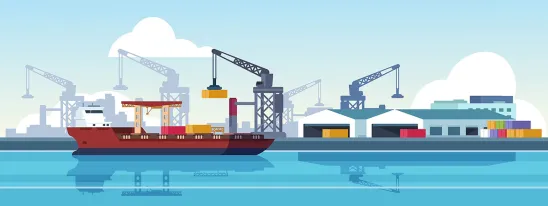As the Biden Administration finds its stride in the first 100 days, we are starting to see movement on several of its key priorities. Chief among them: pivoting to a clean energy economy. A campaign that promised investments of up to $2 trillion in alternative energy saw progress this week, as House Democrats, led by Energy and Commerce Committee Chairman Frank Pallone, Jr. (D-NJ), Environment and Climate Change Subcommittee Chairman Paul Tonko (D-NY), and Energy Subcommittee Chairman Bobby Rush (D-IL), announced a down payment on those hopes with the introduction of the CLEAN Future Act. In our previous KL Gates alert from January, our team discussed how the U.S. maritime industry should expect the issues of clean energy investment and climate resiliency to rise to the very top of the White House’s legislative agenda. This week’s rollout of the CLEAN Future Act further confirms the importance of these priorities, and the far-reaching implications of the reforms offered for the transportation and maritime sectors.
Seeking Clean Energy Solutions
According to Chairman Pallone, the CLEAN Future Act promises to “create millions of homegrown jobs in a climate-resilient economy, ensuring our workers and businesses can compete in the 21st century transition to clean technology”. The 981-page bill would authorize $565 billion in spending over 10 years to accelerate decarbonization efforts. More specifically, the bill would: set an interim national goal to reduce greenhouse gas (GHG) pollution by no less than 50 percent below 2005 levels before 2030, and achieve net-zero GHG emissions before 2050; establish a federal Clean Electricity Standard toward 100 percent clean electricity generation by 2035; set new energy efficiency targets and standards for buildings; provide funding for technical assistance grants to empower environmental justice communities; establish a $100 billion Clean Energy and Sustainability Accelerator; and introduce programs to address the needs of workers and communities affected by the transition to a clean energy economy.
Impacts to the Transportation Sector
The CLEAN Future Act would have massive impacts on every sector of the economy, including several prominent changes to the regulation of the transportation industry. The bill would target transportation emissions (the largest source of GHG pollution) with sizable investments in transportation electrification, new federal grant programs, and various other incentives to accelerate the transition to a zero-emissions future. Provisions of interest to the transportation industry include language that would: authorize $500 million for electric vehicle supply equipment; $2.5 billion/year to transition to zero-emissions school buses; expand domestic manufacturing of advanced vehicles; $375 million for the Clean Cities Coalition Program; and increase the percentage of alternative fueled vehicles acquired in federal agency fleets.
Maritime Industry Braces for Change
A significant amount of the attention surrounding clean energy investment in the transportation sector has been focused on the adoption of electric vehicles, but it is also important to note the considerable impacts that will be felt by the maritime industry. The CLEAN Future Act makes major changes to the regulation and standards of GHGs with respect to both vessel and port operations, including a new directive that the EPA Administrator promulgate standards for emissions of GHGs for every class or category of new non-road engines and new non-road vehicles, a broad definition that includes ships. In instituting successive emission standards, the EPA would ensure that emissions continually decrease, and those standards are based on the degree of reductions needed to achieve national goals. The legislation would also establish national goals for reducing methane emissions from the oil and natural gas sector, and form a technology commercialization program to reduce oil and gas industry emissions.
Additionally, the bill includes a title related to environmental justice issues, which seeks to empower the communities that experience a disproportionate burden of the negative human health and environmental impacts of pollution or other environmental hazards. The bill creates more access to public information and opportunities for meaningful participation related to human health and environmental planning, as well as directing environmental justice grants to eligible entities to foster participation in decisions impacting the health and safety of their communities.
Clean Ports Initiatives
The CLEAN Future Act also proposes substantial investments and long-term reforms to the operation of U.S. ports, including reauthorizing the Diesel Emissions Reductions Act (DERA) National Grants Program at $500 million/year in FY22-31. DERA solicits applications nationwide for projects that achieve significant reductions in diesel emissions and exposure, particularly from fleets operating in areas designated by the EPA Administrator as poor air quality areas.
In addition to a plus up in DERA funding, the bill would amend the Energy Independence and Security Act to include projects facilitating electrification of the transportation sector, projects involving ground support equipment at ports, and projects deploying electric vehicle charging infrastructure. The original act created this competitive program to provide grants on a cost-shared basis to carry out projects that encourage the use of electric vehicles or vehicle technologies. This update would expand project eligibility, and reauthorize the program at $2 billion/year in FY22-31, and an additional $2.5 billion/year for large-scale projects to electrify the transportation sector.
Additionally, the bill would establish a new EPA grant program aimed at reducing GHG emissions and other air pollution at U.S. ports. The federal grants could be used to develop climate action plans, and to implement measures that reduce emissions from port infrastructure and operations through the purchase and installation of zero-emission equipment and technology. Notably, using a grant to purchase fully automated cargo-handling equipment would not be permitted. The grant program would also set stringent labor standards and metrics by which EPA must prioritize consideration of proposed projects. To assist with the formation of actionable data, the EPA would develop methodologies that ports could use to implement emissions accounting and inventory practices, in support of their climate action plans. These programs would be authorized at $2 billion/year in FY22-31, as well as $50 million for the development of climate action plans.
Finally, the package would direct the EPA Administrator, in consultation with the Secretary of Energy, to conduct a study on port electrification, which would examine the benefits to surrounding communities, effects on air quality, how emerging technologies may be used, and how ports can partner with electric utility owners and operators.
The CLEAN Future Act is an ambitious legislative package, with a large price tag, many conflicting interests, and an unclear path in the tightly split and historically more measured U.S. Senate. However, any doubts about the inevitability of a pivot to a clean energy future should be tempered, as we are now in a political climate where even a top trade association representing the oil and natural gas industry appears poised to embrace putting a price on carbon emissions. The future of this bill as standalone legislation may be uncertain, but the parts of the whole, and the intent and purpose of the legislators is anything but. Large-scale reforms to the way that we understand the production, consumption, and disbursement of energy are to be expected in the years to come, particularly in the transportation sector.









 />i
/>i
